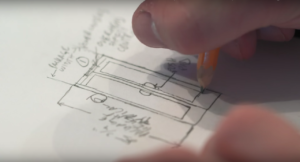“Great video comes from thinking humans, not equipment.” ― Steve Stockman
As a thinking human, you may want to consider generating a storyboard for your video concept. Storyboards help to keep everyone working on a visual project all on the same page and are the best way to share your vision with others. They're an important step in the production process when several creatives need to collaborate or when you need to represent visuals to a client.
Once your script has approval, the storyboard can be created. Important details to determine when developing your storyboard can include how many scenes you'll need to outline, level of detail, key images, voiceover/music notes, and overall style. Depending on the level of complexity, you might not need a storyboard for every video, but they're a must when you're working in teams or shooting on location.

Here are some things to think about when looking at, creating, or approving a storyboard:
- Storyboards outline all the parts of a production to keep it organized. This includes voice talent, actors, scripts, props, settings, camera angles, locations. The more elements you have in a production, the more complex your storyboards will be to accommodate that information.
- Creating a storyboard will help you plan for special effects and test complicated ideas on paper before actually filming on location.
- Storyboards explains the actions occurring in each frame. They provide explicit details and the ideas behind what is happening in each frame, such as: "John throws keys to Marsha." (Thanks, Marsha!) Often storyboards include arrows or instructions that indicate movement.
- Each frame of a storyboard includes character dialogue. For each frame in the storyboard, the intended dialogue is written out, for example, John: "Marsha, why don't you pick up lunch while you are out?" (Thanks again, Marsha!)
- A storyboard describes the additional audio needed. For each frame, it adds details about any extra audio in the scene, including who is speaking, off camera lines, sound effects and background music.
- The storyboard gives camera instructions. It explains what the camera is doing for each particular frame, for instance, "Camera follows Marsha as she walks to the door." (Bye-bye Marsha!)
- Storyboards provide details on visual effects. Include any visual effects to add after filming your commercial to the frame in which they will appear. For example, if your character is talking about a damaged car, mention in your storyboard that a picture of the car is in the corner of the screen. Also, if there is audience interaction like a link or a phone number that will be added later, that and any additional graphics should go onto the storyboard as well.

Beyond the client's checklist for TV Commercial storyboards above, there are a few other things to consider. An approved storyboard will save you money. Crafting all the visuals in pre-production will keep the production costs down and keep you from having to re-shoot footage. And storyboards make sure clients and video editors are on the same page. A storyboard isn't high-level art, it is usually either a black and white or color sketch outline for the scope of the production.
An advantage of using storyboards is they allow you to experiment with changes in the story line BEFORE filming begins. A study done on predicting TV commercial effectiveness from storyboards indicates something very important: "the relatively simple images and narrative of storyboards have a reliable predictive value for the impact that TV commercials will have that are made according to the storyboards." On the whole, the study finds that negative emotions, fear, anger, and disgust are the most reliably predicted. The study also shows that novelty catches hold people's attention. It's an interesting study, and makes the argument that storyboards are an even more important tool for testing consumer behavior and conversion early on in the production process. #FoodForThought #PredictiveMarketing
Miceli Productions has offered hands-on high quality commercial photography and video production for the over 14 years. We handle all aspects of our video production projects, including creative direction, script writing, casting, voice over, and filming through post production editing, audio, and animation graphics. To Learn How to Use Video for Business, download our free e-book.

